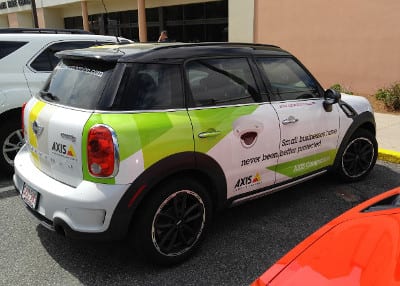Advertising vehicles: learn more about this mobile OOH advertising tactics.
A survey conducted by the platform Numerator indicated many industries are shifting their messaging to in-home delivery. As example, restaurants are pivoting to food delivery messages. The increased “work from home” period will force the shift of advertising concepts. Numerator reported that Burger King and Little Caesars are even advertising new delivery options available in their stores.
Adzze has been adapting the advertising vehicles to a more sensitive message. The team has working on extending its capabilities to offer advertising vehicles that can reach the consumers at their safest place: at home. One of these concepts uses pizza boxes as advertising space. Think of this as small moving billboard that gets delivered at the consumer’s home. Studies demonstrated that this type of ad can evoke an 80% recall rate (8 out of 10 households individuals remember to see an ad on the pizza box) with an average ROI of 150%. This means, that for every 1 dollar the advertiser invested in a pizza box advertising campaign, they received at least an additional 2.5 dollars of sales. For more details see the article Estimating the ROI of Pizza Box Marketing.
There is no doubt that you have seen huge trailers branded with company logos and juicy messages. It is due to the efforts of companies to ensure that as many people as possible get to know their brand. Advertising vehicles are an increasing sight on our roads, especially as the costs of traditional and digital media advertising hike.
Mobile OOH
Sure, many businesses advertise to drive sales. For every impression that an ad generates, one expects the sales numbers to increase. However, repeated impressions do more than just drive sales. The more the targeted audience encounters your brand, the more they become aware of it. Therefore, putting money in ad campaigns to drive sales is placing money into driving brand awareness. People buy from a familiar brand, one that they are of, and one that exists.
Many marketers treat brand awareness as the route to conversion. It is an interesting observation considering that the central thesis of digital marketing (soon to be the largest ad platform in the US) is conversion. Nevertheless, some businesses do acknowledge that brand awareness is critical. According to a Tinuiti study, about 42% of the money spent on ads on Amazon’s DSP went to driving brand awareness.

Why you should choose advertising vehicles
Businesses are flocking to Amazon and other digital platforms to increase brand awareness. Perhaps, this could be the driver behind the rise of digital ad platforms worldwide. However, this does not rule out the popularity of advertising vehicles in the quest to drive up brand awareness.
One of the reasons branded cars are a favorite for businesses is the low cost of branding a car. For example, branding a smart car in Massachusetts costs just over $21,000 per year. The cost is inclusive of buying the smart car, paying state taxes, fully wrapping the car with the advertisement, a full year’s insurance for one driver, and gas per year.
In comparison, the cost of a large billboard in Boston, MA, is about $4,000 per location for four weeks. For one year, a business forks out not less than $52,000 to maintain a billboard at a single location. Branded cars attract a single hefty upfront cost but remain cheap to continue after that.
Further, branded Advertising Vehicles are eye-catching. Once you hit the highway, the number of eyeballs that will encounter the ad are many. In traffic, the continued exposure of the advertisement to drivers and pedestrians increases the impressions generated. Ultimately, branded cars offer a simple yet effective marketing avenue.
The Ad industry will focus on Stay-at-Home vehicles
Recently the Interactive Advertising Bureau surveyed nearly 400 media buyers and brands. The results were surprising: 74% think the coronavirus pandemic will have a larger impact on their advertising spend than the 2008 financial crisis. According to the President of the Interactive Advertising Bureau, David Cohen, “Typically marketers will press pause for a moment, take a breath, assess the situation, replay and reevaluate.”
The use of mobile OOH methods will most likely experience more decline in the coming months, given the fact when the economy re-opens, people will still be cautious and stay more at home. Mobile advertising using trucks, buses, and others will be quickly replaced by in-home advertising. The impact of COVID-19 has kept normally mobile citizens inside their homes. Hence, the best way to reach your audience and maintain brand visibility will be to take your products and services to them indoors, as it will be clearly unprofitable to place adverts on advertising vehicles that no one is seeing.
Brands are looking for alternatives to static traditional OOH advertising as vehicle advertising or digital mobile OOH. The use of ads on advertising trucks has been emerging as an unconventional tactic however it has risks related to the impact on reputation. When the vehicle carries the advertisement of the brand on the road, the Advertising Vehicle serves as the brand ambassador. Any driving misbehavior could impact directly the brand image. In addition, advertising vehicles have several pitfalls as low return on the ad investment, difficult to track the outcomes, and low brand recall. Advertising vehicles cannot target precisely the exact audience as any traffic driver could be targeted. There are some parts of the country and others globally, with restrictions on billboards. As such, advertisers cannot access the areas during an ad campaign. In such a situation, truck-side advertising is an ideal alternative. Notably, advertisers can attach different types and sizes of billboards on the side of trucks.
Admittedly, advertising vehicles travel far and wide and the car wraps are eye-catching. However, this does mean that the people that see the ads actually make direct action. Usually, the direct actions that the audience makes translates to conversion rates. The conversion rates here are poor because of the inability to target the precise audience.






